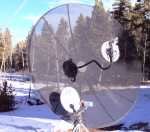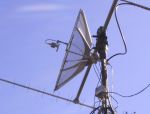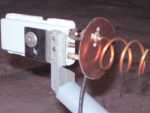Using TVRO Dish for a Ham Antenna
Dishes for Amateurs

The price was right for this dish - FREE. Wives call them BUDs (Big Ugly Dishes). It was originally used for 4 GHz TV Receive Only (TVRO). Replacing the C band feed at the focal point turned it into a great ham antenna. On a 10' dish, the tri band feed has measured 35 db of gain on 2401 MHz, 29 db of gain on 1269 MH, and 18 db on 435 MHz. 35 db of gain makes a 1 watt signal sound like 2 KW! This feed system works AO-40 with as little as 1/10 of a watt on 1269 MHz achieving maximum allowed signal level into AO-40. Take the C band feed off that old TVRO dish and attach a ham band feed system and convert the mount to elevation and azimuth automatic control for a great ham satellite antenna system.

A TVRO dish can be can be converted with minimal effort to function very well in a number of uses. Other uses are EME (Earth-Moon-Earth) experiments, Radio Astronomy, and SETI (Search for Extraterrestrial Intelligence).
TVRO dishes should work great on DSP EME.
Amateur Dish Types
Dishes come in many sizes and shapes. Each has advantages and disadvantages, so it is important to understand several items. Don't start off on a giant sized dish; start small and build up to the giant sized dish. Doubling the size of your dish will gain you 3 db, but may take 20 db of effort!
General - Diameter, Focal Length, Construction, Gain, Beamwidth, & Windloading
Small - 18" Hubcaps, 3' Barbecue Grills, PrimeStar Offset fed
Medium - 4' Aluminum solid, 5' Aluminum mesh, 6' Aluminum solid, 7 1/2' Aluminum mesh
Large - 10' Steel Mesh, 10' - 14' Fiberglass, 15' - 16' , Giants

Dish Feed Systems
You have to put out a signal to the dish or receive a signal reflected by the dish. But all dish feed systems are not equal, and a dish feed system that works great on one dish may be a real loser on another dish. At 2401 MHz, a Campbell's soup can lid makes a nice antenna and a peach can makes a scalar ring reflector.
Dipoles & Reflectors
Single band Helix (2401 MHz)
Dual band helices (435 MHz & 2401 MHz)
Single band Patches (2401 MHz), (1691 MHz) and (1420 MHz)
Dual band feed systems (435 Mhz & 2401 MHz) and (1269 MHz & 2401 MHz)
Triband patch feed system (435 MHz, 1269 Mhz, & 2401 MHz)
Dual circularity patch feed systems for AO-40 & EME with your TVRO dish.
Rigs and Coax for Amateur Satellite Communication
There are many potential rigs, but only 4 top runners. Some satellites are FM, but most are SSB and CW satellites. Get a good all mode rig and antennas to match. I connected an ICOM PCR-1000 PC based receiver to my satellite station so I can see all the satellite activities at one glance. Amazing what you can see. The signal coming down from AO-40 is not very strong. And the stations are 10 db (almost 2 S units) below the beacon's strength resulting in a very poor signal to noise ratio. It's like listening to a wisper coming from behind a waterfall. But by eliminating the waterfall with a good DSP unit and proper use of the RF gain control, you can easily hear the weak ones. Several have asked what AO-40 stations sound like on my 14' dish. About like a close by 2 meter repeater. I consistently work any station in 1/2 the world at a time running 1/2 watt into the 1269 patch section of my triband patch in front of the 14' dish. Now that's QRP!
Dish Rotators
Small dishes with low gain and a large beamwidth can easily be moved manually so they see the satellite. But the bigger the dish, the more you will want a means to remotely move the dish.
TV antenna rotators
Ham-M seies rotators
Yaesu G-5400, G-5600, & G-5500
Linear Arms
Gearmotors, Sprockets, Chain Drives, and Pulleys
AC and DC Motors
Most of the time, 435 MHz is the downlink (your receive) frequency, but a few satellites use 145 MHz as the downlink frequency, so a pair of preamplifiers is appropriate for an "any satellite station". Good coax is a must on these frequencies. Use coax with less than 3 db of loss at the frequency desired and the length needed. I use about 80' of 1/2" hardline between the station and the preamplifiers. Figure on about 1000 watts ERP max to work the various LEOs. Occasionally you will run across EME power levels being used that cause AGC clamping that screws up the other QSOs on the satellite. Never exceed the signal level of the beacon is a good rule of thumb.
For more info on the types of dishes used in amateur work,
click on the article title link.

The price was right for this dish - FREE. Wives call them BUDs (Big Ugly Dishes). It was originally used for 4 GHz TV Receive Only (TVRO). Replacing the C band feed at the focal point turned it into a great ham antenna. On a 10' dish, the tri band feed has measured 35 db of gain on 2401 MHz, 29 db of gain on 1269 MH, and 18 db on 435 MHz. 35 db of gain makes a 1 watt signal sound like 2 KW! This feed system works AO-40 with as little as 1/10 of a watt on 1269 MHz achieving maximum allowed signal level into AO-40. Take the C band feed off that old TVRO dish and attach a ham band feed system and convert the mount to elevation and azimuth automatic control for a great ham satellite antenna system.

A TVRO dish can be can be converted with minimal effort to function very well in a number of uses. Other uses are EME (Earth-Moon-Earth) experiments, Radio Astronomy, and SETI (Search for Extraterrestrial Intelligence).
TVRO dishes should work great on DSP EME.
Amateur Dish Types
Dishes come in many sizes and shapes. Each has advantages and disadvantages, so it is important to understand several items. Don't start off on a giant sized dish; start small and build up to the giant sized dish. Doubling the size of your dish will gain you 3 db, but may take 20 db of effort!
General - Diameter, Focal Length, Construction, Gain, Beamwidth, & Windloading
Small - 18" Hubcaps, 3' Barbecue Grills, PrimeStar Offset fed
Medium - 4' Aluminum solid, 5' Aluminum mesh, 6' Aluminum solid, 7 1/2' Aluminum mesh
Large - 10' Steel Mesh, 10' - 14' Fiberglass, 15' - 16' , Giants

Dish Feed Systems
You have to put out a signal to the dish or receive a signal reflected by the dish. But all dish feed systems are not equal, and a dish feed system that works great on one dish may be a real loser on another dish. At 2401 MHz, a Campbell's soup can lid makes a nice antenna and a peach can makes a scalar ring reflector.
Dipoles & Reflectors
Single band Helix (2401 MHz)
Dual band helices (435 MHz & 2401 MHz)
Single band Patches (2401 MHz), (1691 MHz) and (1420 MHz)
Dual band feed systems (435 Mhz & 2401 MHz) and (1269 MHz & 2401 MHz)
Triband patch feed system (435 MHz, 1269 Mhz, & 2401 MHz)
Dual circularity patch feed systems for AO-40 & EME with your TVRO dish.
Rigs and Coax for Amateur Satellite Communication
There are many potential rigs, but only 4 top runners. Some satellites are FM, but most are SSB and CW satellites. Get a good all mode rig and antennas to match. I connected an ICOM PCR-1000 PC based receiver to my satellite station so I can see all the satellite activities at one glance. Amazing what you can see. The signal coming down from AO-40 is not very strong. And the stations are 10 db (almost 2 S units) below the beacon's strength resulting in a very poor signal to noise ratio. It's like listening to a wisper coming from behind a waterfall. But by eliminating the waterfall with a good DSP unit and proper use of the RF gain control, you can easily hear the weak ones. Several have asked what AO-40 stations sound like on my 14' dish. About like a close by 2 meter repeater. I consistently work any station in 1/2 the world at a time running 1/2 watt into the 1269 patch section of my triband patch in front of the 14' dish. Now that's QRP!

Dish Rotators
Small dishes with low gain and a large beamwidth can easily be moved manually so they see the satellite. But the bigger the dish, the more you will want a means to remotely move the dish.
TV antenna rotators
Ham-M seies rotators
Yaesu G-5400, G-5600, & G-5500
Linear Arms
Gearmotors, Sprockets, Chain Drives, and Pulleys
AC and DC Motors
Most of the time, 435 MHz is the downlink (your receive) frequency, but a few satellites use 145 MHz as the downlink frequency, so a pair of preamplifiers is appropriate for an "any satellite station". Good coax is a must on these frequencies. Use coax with less than 3 db of loss at the frequency desired and the length needed. I use about 80' of 1/2" hardline between the station and the preamplifiers. Figure on about 1000 watts ERP max to work the various LEOs. Occasionally you will run across EME power levels being used that cause AGC clamping that screws up the other QSOs on the satellite. Never exceed the signal level of the beacon is a good rule of thumb.
For more info on the types of dishes used in amateur work,
click on the article title link.

1 Comments:
Whenever you think about television you want hundreds of channels and dishnetworkonline can provide that.
We are also on Facebook, MySpace, Twitter and Orkut.
By Unknown, at 3:03 PM
Unknown, at 3:03 PM
Post a Comment
<< Home